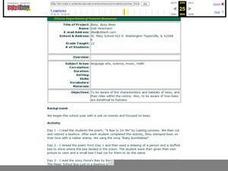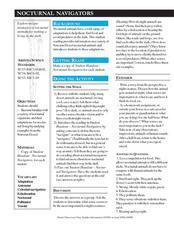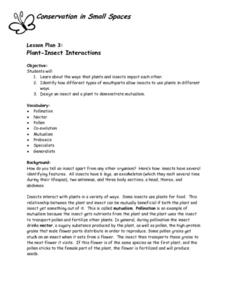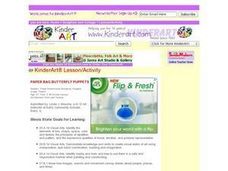Cornell University
Insect Anatomy
Young entomologists discover insect anatomy in a very detailed unit plan. Offering background information for teachers about various insects, class members explore the differences between bugs and insects—and yes, there are many...
Curated OER
Termite Biology
Learners explore the physical characteristics, distribution and habitat of termites. The lesson focuses on the termite as a social creature contrary to most other insects.
Curated OER
Mayfly and Stonefly Comparison Chart
In this insects worksheet, learners complete a graphic organizer by comparing the body structure of the mayfly and stonefly nymphs and adults. Then students draw each one.
Curated OER
Science: Bugs and Body Parts
Students determine the function of various insect parts they have observed. Using descriptive words, they explain the insects' characteristics and draw pictures of them. The instructional activity concludes with students writing short...
Curated OER
Insects
Students, through books, videos, and readings, explore characteristics of insects. In groups, they choose an insect to research. Students discover their insect's diet, how they move, and where they live. Afterwards, they use the facts...
Curated OER
World of Insects
For this biology worksheet, learners identify and locate various vocabulary terms related to the world of insects in the puzzle. There are 51 words to locate in the word search.
Curated OER
Fundamentals of Radio Communication
Twelfth graders explain the role of electromagnetic waves and antenna in radio communication. In this lesson, 12th graders examine circuit diagrams and solve wave related problems. They also calculate theoretical antenna length for...
Curated OER
Busy, Busy Bees
Students role play bees finding nectar. they put on bee tails and antenna. Then 3 or 4 students at a time performed the dances bees do when one is communicating to the others that he has found nectar and the when they are close the...
Curated OER
Parts of an Insect
In this science worksheet, students read about the three parts of an insect. Students also analyze a labeled picture of an insect that shows its mouth, antenna, head, led, thorax, and abdomen.
Curated OER
Insect Safari
Third graders name and identify three body parts of an insect, identify the characteristics that insects have six legs and one pair of antennae and categorize insects as to whether they are helpful or harmful.
Curated OER
The Young Virginia Gardener: Garden Pests and Problems-Insects
In this garden pests and problems worksheet, students read about insects and research what insects use their antenna for, comparing 2 or 3 different types.
Curated OER
Edible Bug Project
Students recognize the characteristics of insects. In this edible bugs activity, students observe the body parts of an insect. Students create an edible insect using a grape, carrot sticks and sorrel stems and leaves. Students share...
Curated OER
Spring into Poetry
How many different types of poetry are there? Let me count them; list poems, haiku, and makes-me-think poems are only a few. Learners create their own poems accompanied by artistic projects such as haiku poems written on kites.
Desert Discoveries
Nocturnal Navigators
Young biologists take a look at some of the unique ways that nocturnal animals survive in the dark. After reading a terrific student handout which is embedded in the plan, learners work together to answer questions about what they have...
Curated OER
Butterfly Life Cycle
Create colorful butterfly models that display the stages in a butterfly's life with young learners. They will identify the stages in a butterfly's life cycle. Then they will create a butterfly model, arranging the stages of a butterfly's...
Curated OER
Preposition House
Identify and use prepositions to describe how objects relate to one another. Each child draws a house and then draws items in, around, on, and under the house to demonstrate different prepositions. Written descriptions accompany their...
New South Wales Department of Education
Invertebrates
Of all invertebrates, insects by far are the most numerous. Scholars discuss invertebrates and then use a key to classify them. They see different examples and must describe features of each organism based upon the key.
Curated OER
Fun with Fictitious Animals
How can one differentiate between a dweezlebub and nessie? Use this fictitious creature dichotomous key to find out! Biologists of all ages will enjoy this creative way to learn about classification, including a chance to draw the...
Terminix
Amazing Insect Facts
Insects are like little aliens living all around us. Explore fun and interesting insect facts by having the class read a short informational paragraph. The paragraph focuses on how we are similar and different to insects and includes...
Biology Junction
World of Insects: Characteristics, Orders, and Collecting
Every bug is an insect, but not all insects are bugs. A presentation lists the characteristics of insects, describes their body parts, and explains metamorphosis. It also details every order and includes photographs and multiple facts...
Curated OER
Egg Carton Lobsters
Who doesn't love learning about the ocean? And who wouldn't want to help create an ocean themed mural? Little learners make lobsters out of recycled egg cartons, pipe cleaners, and paint. These are then used as part of a larger 3-D ocean...
Curated OER
The Amazing Ant
Students explain that ants are an important element of nature's balance. Ants eat many insects and are food to other animals. They watch a video and conduct hands-on activities that give them an excellent overview of the ants role in...
Curated OER
Conservation in Small Spaces: Plant-Insect Interactions
Students explore ways that plants and insects impact each other, identify how different types of mouthparts allow insects to use plants in different ways, and design an insect and a plant to demonstrate mutualism.
Curated OER
Paper Bag Butterfly Puppets
Whether you're using it to tell stories, explore the letter b, or during a life science lesson plan, these butterfly puppets will be a hit. Youngsters use crayons, tissue paper, and paper bags to create butterfly puppets.
Other popular searches
- Antennae Insect
- Antennas
- Antenna Math
- Antenna and Wave Propagation
- Antenna System
- About Smart Antenna
- About Samrt Antenna
- Antenna and Wave Probagation
- Simple Macchine With Antenna
- Parabolic Antenna
- Insect Eyes and Antennas
- Repeater Antennas

























